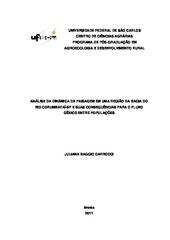Análise da dinâmica da paisagem em uma região da bacia do rio Corumbataí-SP e suas consequências para o fluxo gênico entre populações
Abstract
The Corumbataí River watershed is one of the most degraded areas of the Sao Paulo State due to historical process of use and occupation of their lands. As a result, structural forest fragmentation occurred. These conditions the communities composition and diversity are changed as well as biotic interactions, interfering in gene flow between isolated populations and thus the sustainability of forest remnants. The purpose of this study was to evaluate the changes in land use and cover in the region of Savannah Reserve of Corumbatai, between the years 1978, 1988 and 2000, and its theoretical consequences for gene flow via pollen between populations, using as indicators of habitat quality Euglossina bees. As methodological procedures were used geoprocessing techniques and landscape metrics. The results showed that the process of expansion and intensification of agriculture, especially of sugar cane crop, between the years analyzed was the main cause of deforestation in the region between the period 1978 to 2000, and the savannah was to forest formation the most affected. This process acted in the landscape structural connectivity due to simplify the landscape mosaic, reducing the average size of fragments and increasing isolation among fragments, influencing the functional connectivity of the area to the Euglossina flow. This was mainly due to increasing in the proportion of sugar cane area, crop considered as a barrier to the flow of Euglossina and the reduction of habitats. The results showed that in the study area occurred structural fragmentation process, reflecting in the viii landscape connectivity. This occurred due to inadequate process for use and occupation of land, even after the establishment of conservationists public politics.
